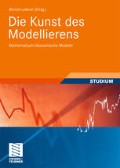Abstract
For about two centuries, the optimal rotation period in timber production has been debated intensively. According to the meanwhile prevalent opinion, the so-called Faustmann condition can cope with the problem. In this way, the present value of forest soil is maximized. The result, however, contradicts the “principle of maximum yield”, i. e. the proposed solution is productively inefficient. The article develops Faustmann’s approach further and provides an objective function which is suited to reconcile the diverging cutting rules.
Preview
Unable to display preview. Download preview PDF.
Literatur
Georg-Ludwig-Hartig-Stiftung (Hrsg.): Biographien bedeutender hessischer Forstleute. Wiesbaden, Sauerländer, 1990
Borchert, Herbert: The Economically Optimal Amount of Timber Cut in Forests. Frankfurt a. M., Sauerländer, 2002
Conrad, Jon M.: Resource Economics. Reprinted 2006. Cambridge u. a., Cambridge University Press, 1999
Deegen, Peter: Aufforstung und Holzeinschlag als Investitionsprobleme in einer statischen Welt. Dresden, TU Dresden, 2001
Endres, Max: Lehrbuch der Waldwertrechnung und Forststatistik. Berlin, Julius Springer, 3. Auflage, 1919
Faustmann, Martin: Berechnung desWerthes, welchenWaldboden, sowie noch nicht haubare Holzbestände für die Waldwirthschaft besitzen. Allgemeine Forst- und Jagd-Zeitung, December 1849, S. 441–451
Helmedag, Fritz: Die optimale Rotationsperiode erneuerbarer Ressourcen. In: Helmedag, Fritz; Backhaus, Jürgen (Hrsg.): Holzwege, Forstpolitische Optionen auf dem Prüfstand. Marburg, Metropolis, 2002, S. 11–42
Helmedag, Fritz: The Optimal Rotation Period of Renewable Resources: Theoretical Evidence from the Timber Sector. In: Kaiser, Dieter G.; Füss, Roland; Fabozzi, Frank (Hrsg): Handbook of Commodity Investing. Hoboken, Wiley, 2008
Huntley, Ian: Forest Management. In: Huntley, I. D.; James, D. J. G.(Hrsg): Mathematical Modelling. Oxford u. a., Oxford University Press, 1990
König, G.: Die Forstmathematik mit Anweisung zur Holzvermessung, Holzschätzung und Waldwerthberechnung nebst Hülftafeln für Forstschätzer. Gotha, in Commission der Beckschen Buchhandlung, 1835
Manz, Peter: Die Kapitalintensität der schweizerischen Holzproduktion. Bern, Paul Haupt, 1987
Moog, Martin; Borchert, Herbert: Increasing Rotation Periods During a Time of Decreasing Profitability of Forestry – a Paradox? In: Forest Policy and Economics, 2, 2001, S. 101–116.
Ohlin, Bertil: Concerning the Question of the Rotation Period in Forestry. In: Journal of Forest Economics, 1, 1995, S. 89–114 (Übersetzung des Originals aus dem Jahr 1921)
Osmaston, F. C.: The Management of Forests. London, George Allen and Unwin, 1968
Pressler, Max Rob.: Der Rationelle Waldwirth und sein Waldbau des höchsten Ertrags. Zweites (selbstständiges) Buch. Die forstliche Finanzrechnung mit Anwendung auf Wald- Werthschätzung und -Wirthschaftsbetrieb. Dresden, Woldemark Türk, 1859
Sagl, Wolfgang: Bewertung in Forstbetrieben. Berlin, Wien, Blackwell Wissenschafts- Verlag, 1995
Samuelson, Paul A.: Economics of Forestry in an Evolving Society. In: Economic Inquiry, 14, 1976, S. 466–492
Scorgie, Michael; Kennedy, John: Who Discovered the Faustmann Condition? In: History of Political Economy, 28, 1996, S. 77–80
Varian, Hal R.: Grundzüge der Mikroökonomik. München,Wien, Oldenbourg, 7. Auflage, 2007
Author information
Authors and Affiliations
Corresponding author
Editor information
Rights and permissions
Copyright information
© 2008 Vieweg+Teubner Verlag |GWV Fachverlage GmbH, Wiesbaden
About this chapter
Cite this chapter
Helmedag, F. (2008). Was lange währt, wird endlich gut: Die optimale Umtriebszeit in der Forstwirtschaft. In: Luderer, B. (eds) Die Kunst des Modellierens. Studienbücher Wirtschaftsmathematik. Vieweg+Teubner Verlag, Wiesbaden. https://doi.org/10.1007/978-3-8348-2692-3_10
Download citation
DOI: https://doi.org/10.1007/978-3-8348-2692-3_10
Publisher Name: Vieweg+Teubner Verlag, Wiesbaden
Print ISBN: 978-3-8351-0212-5
Online ISBN: 978-3-8348-2692-3

